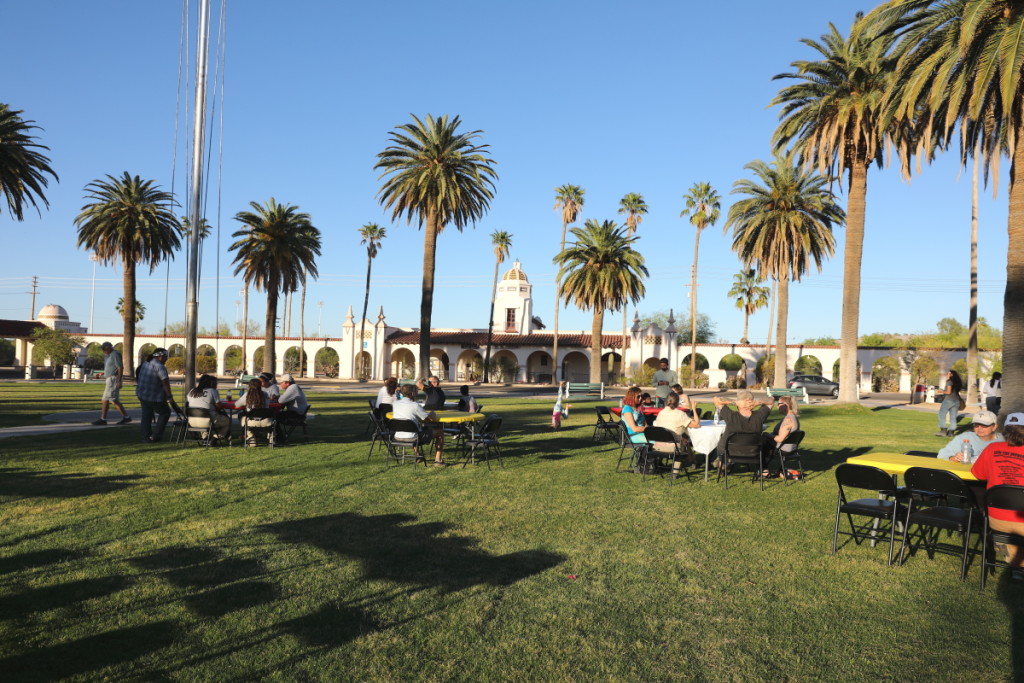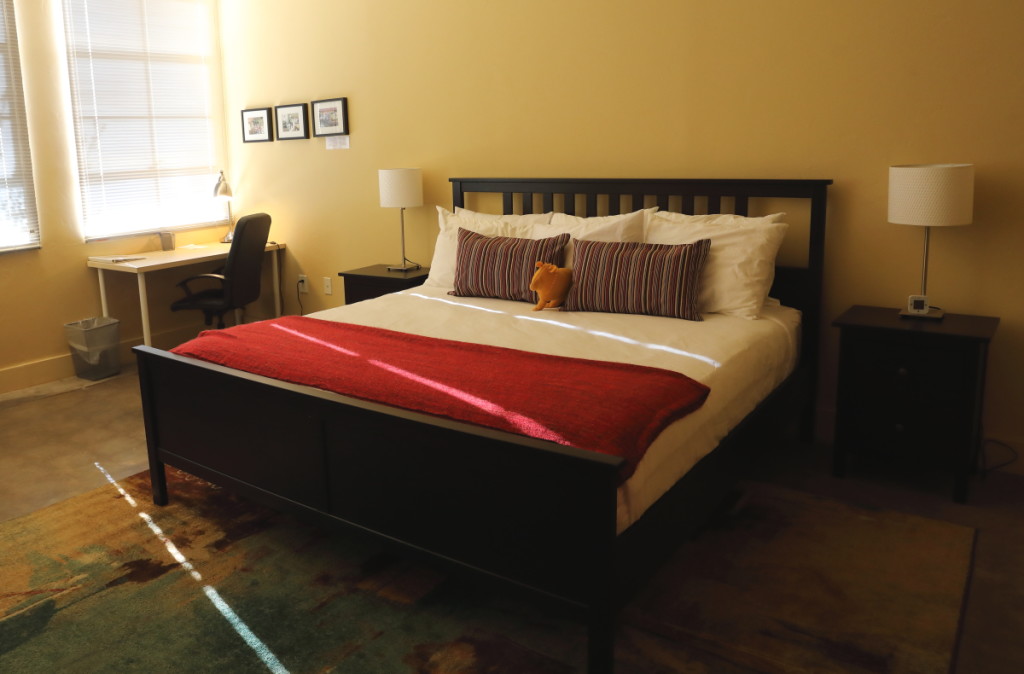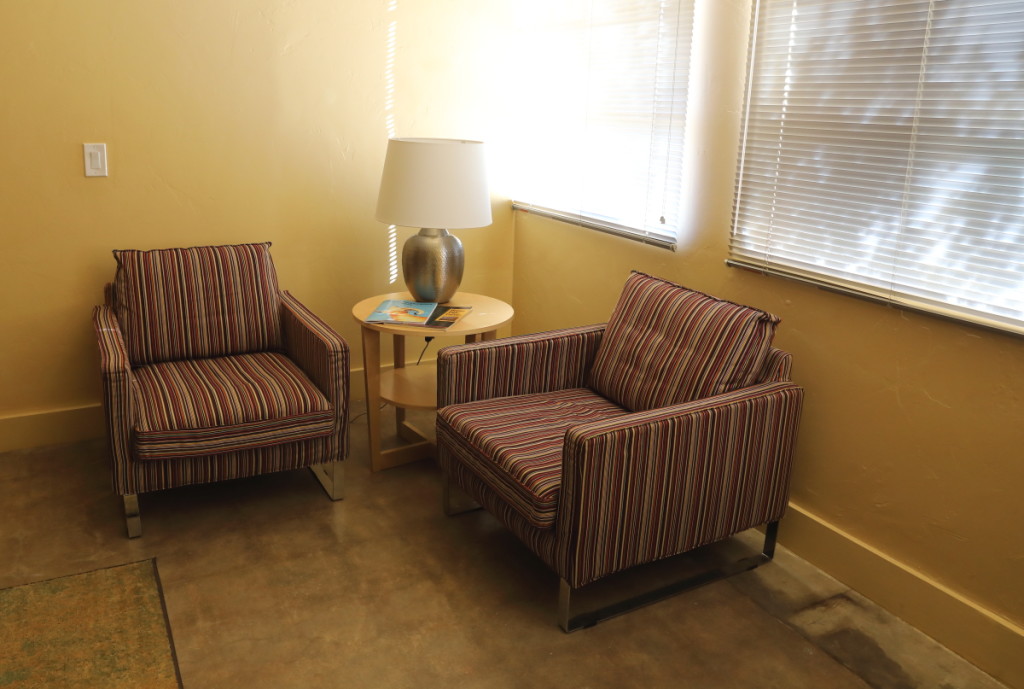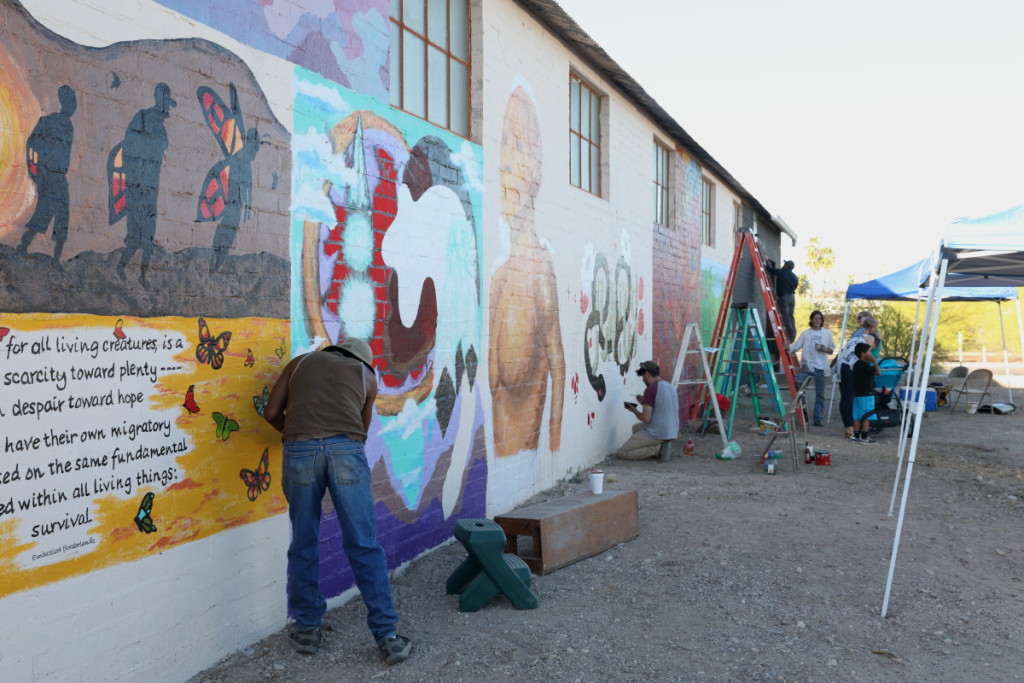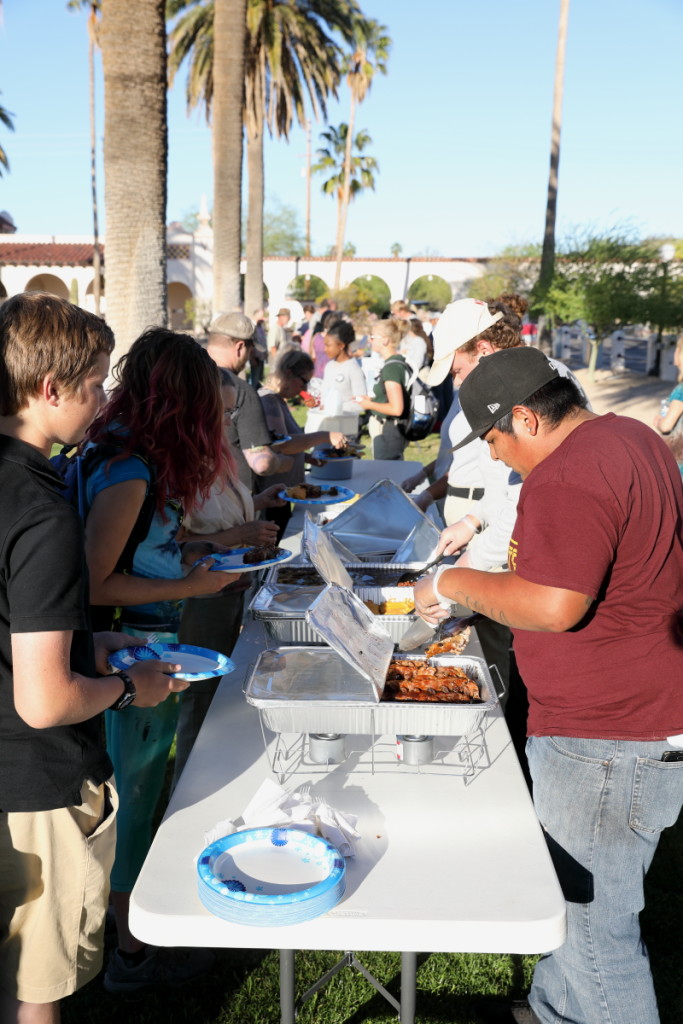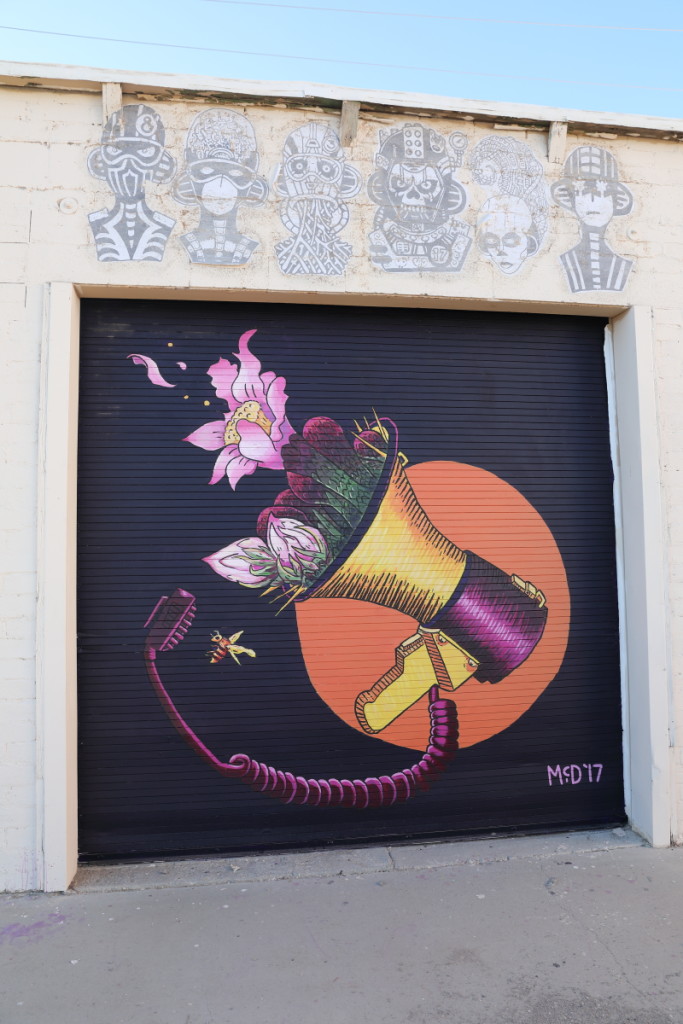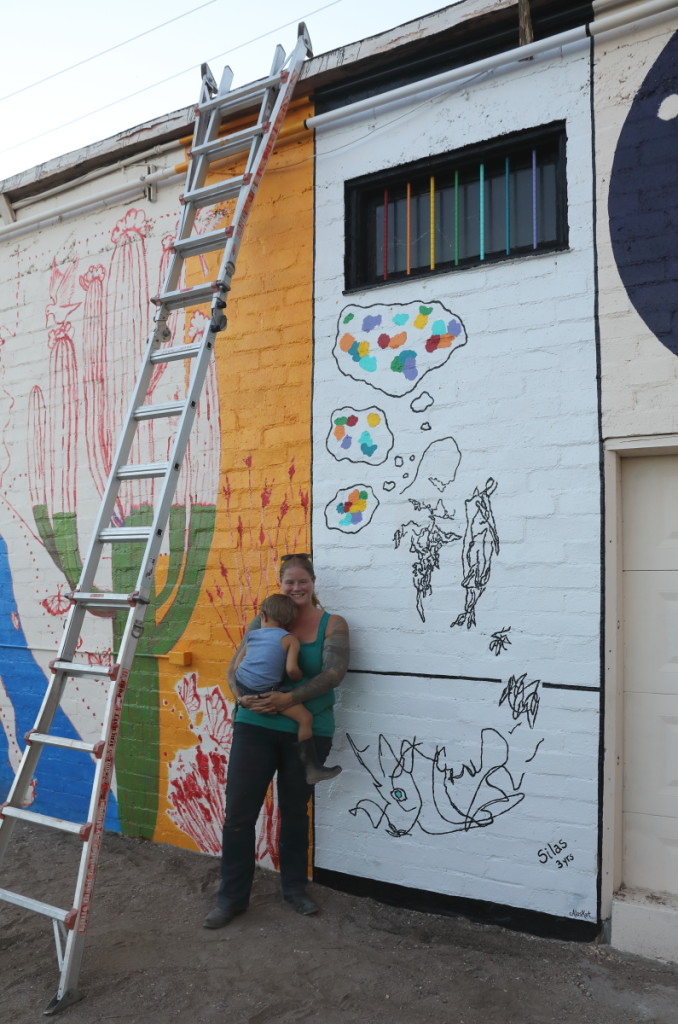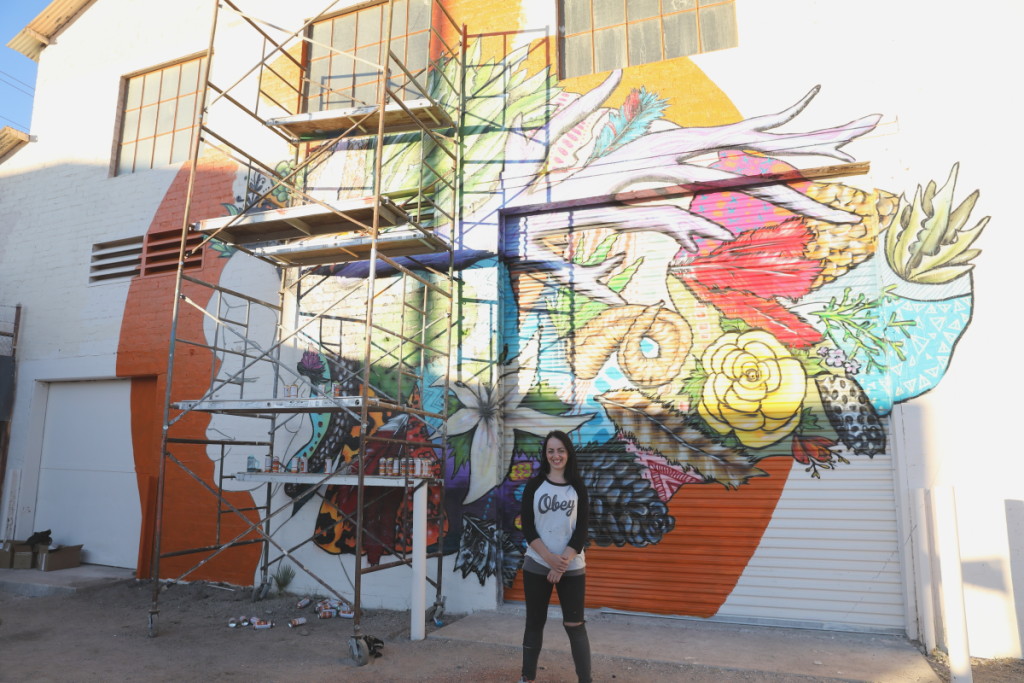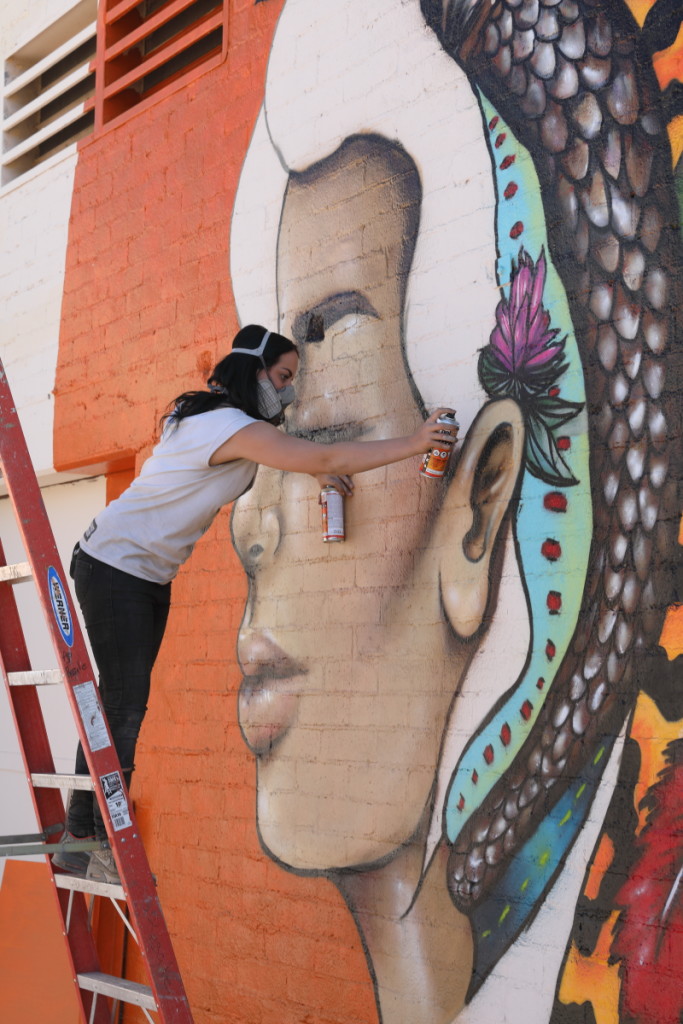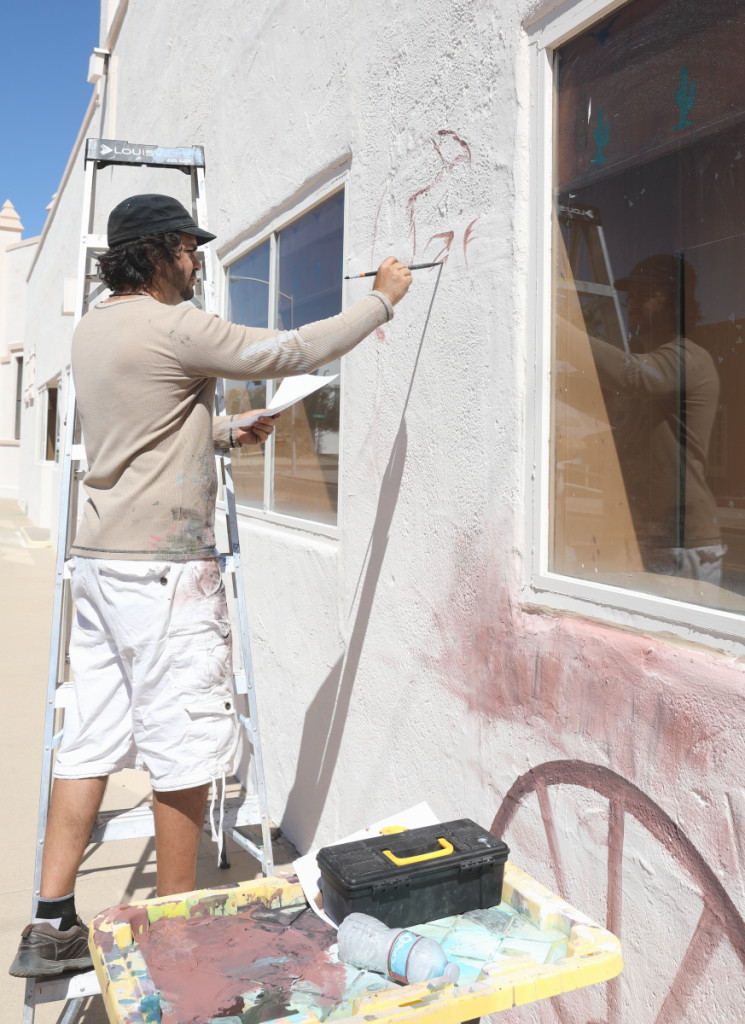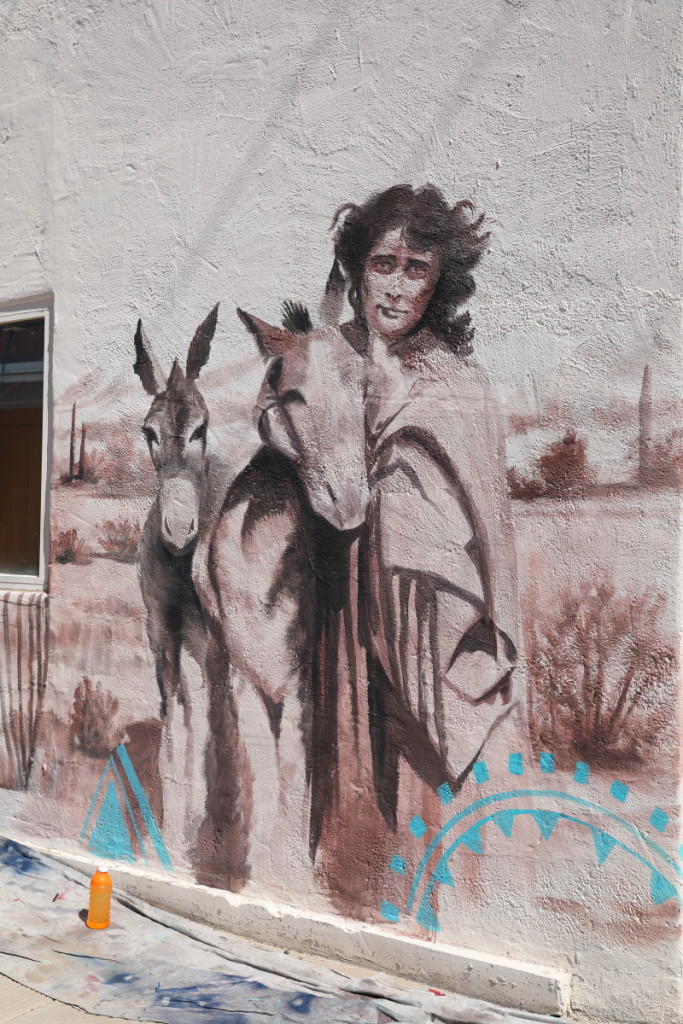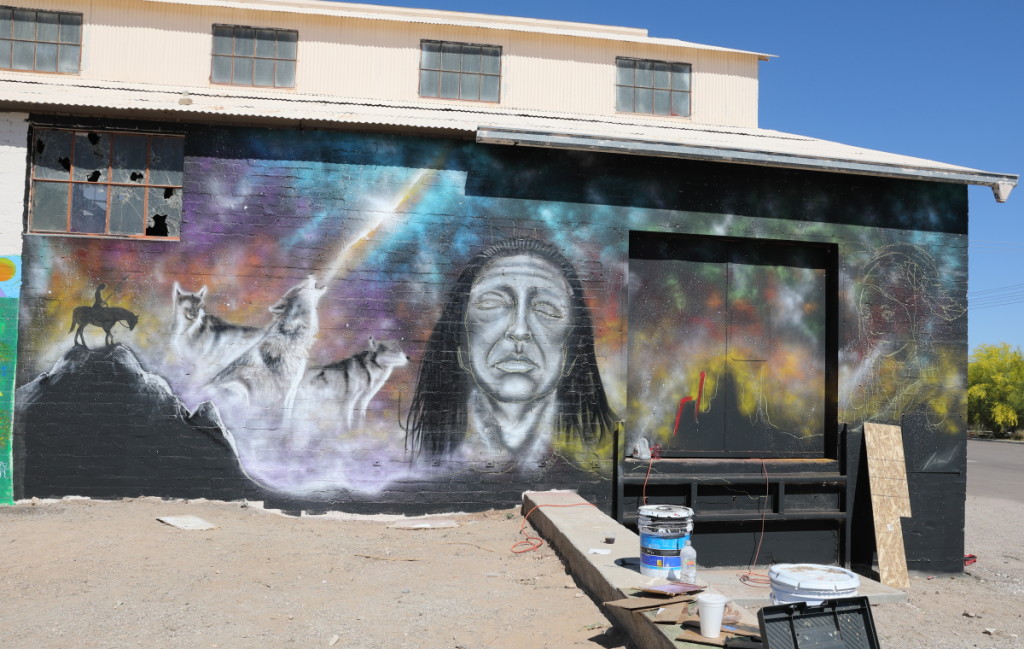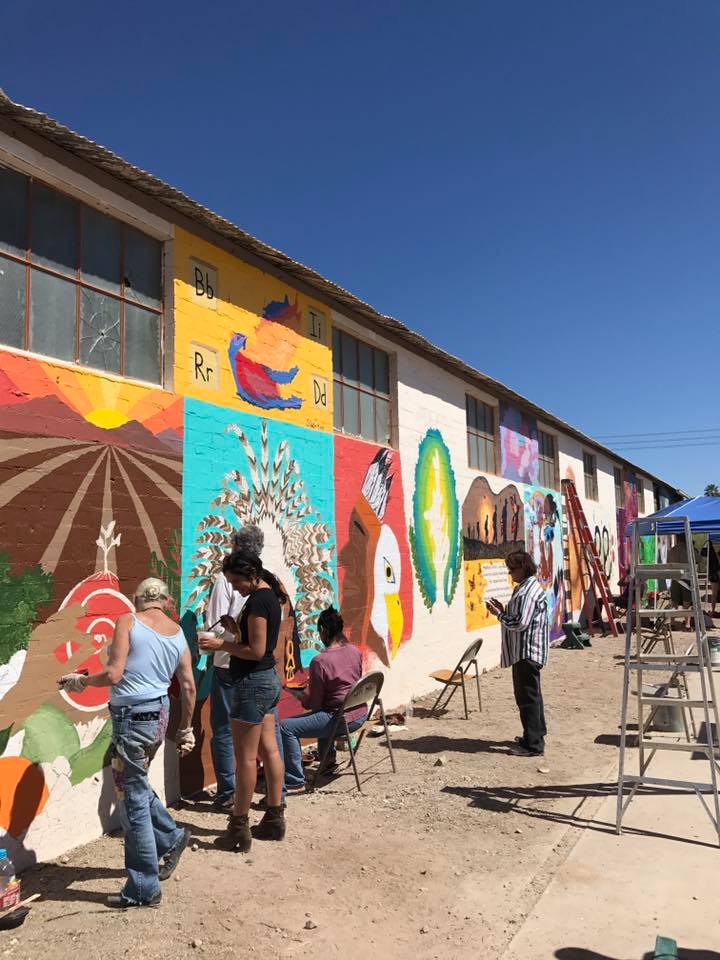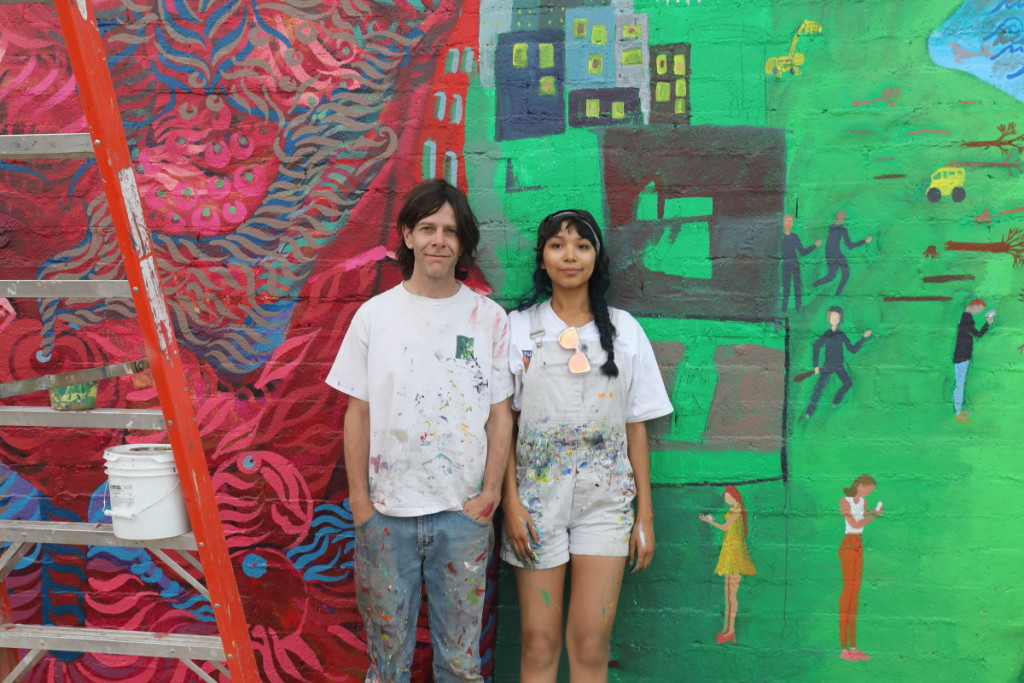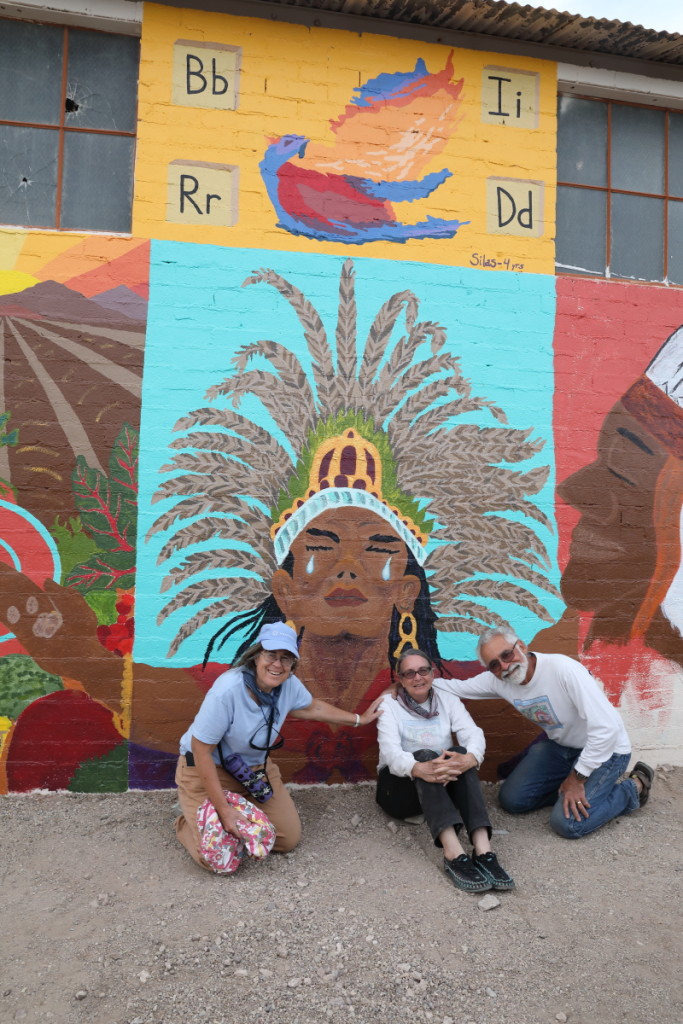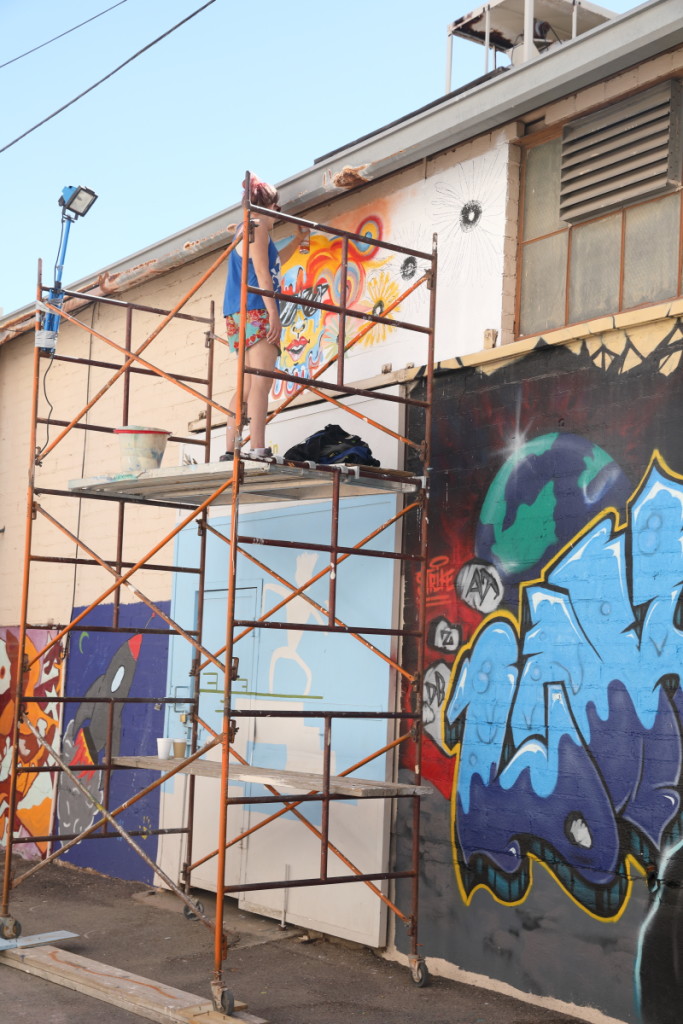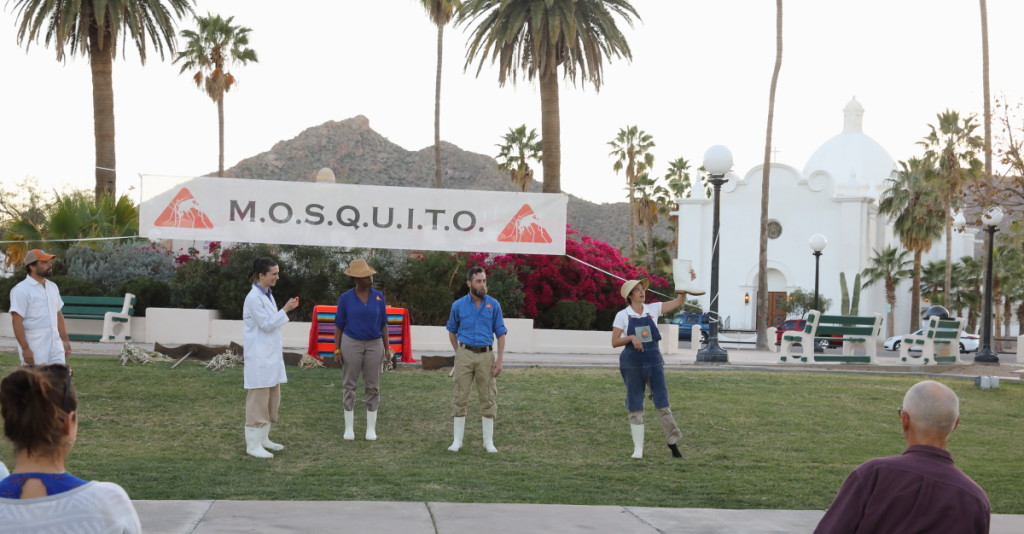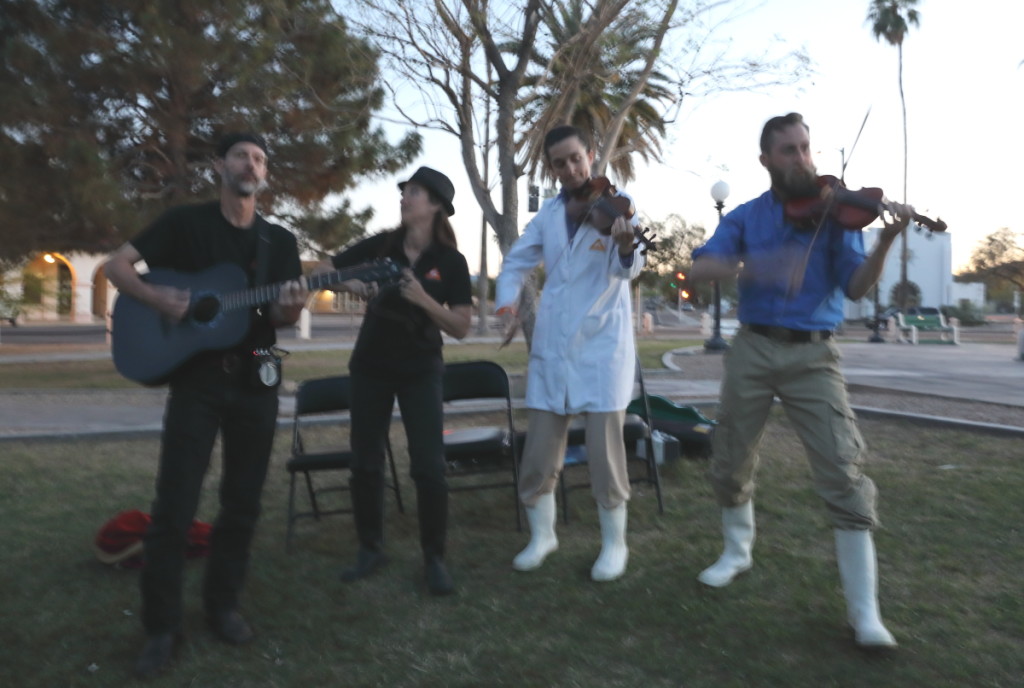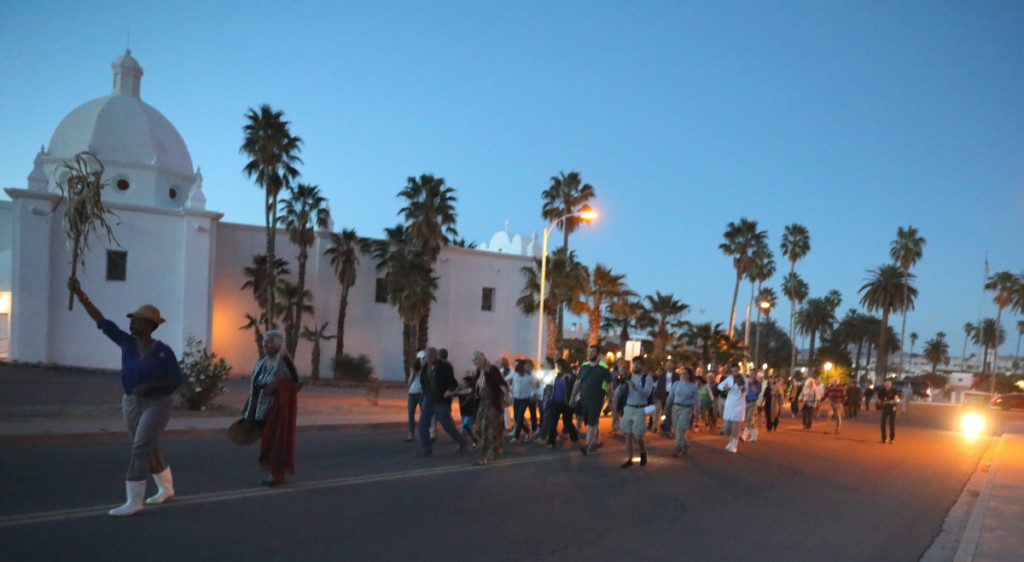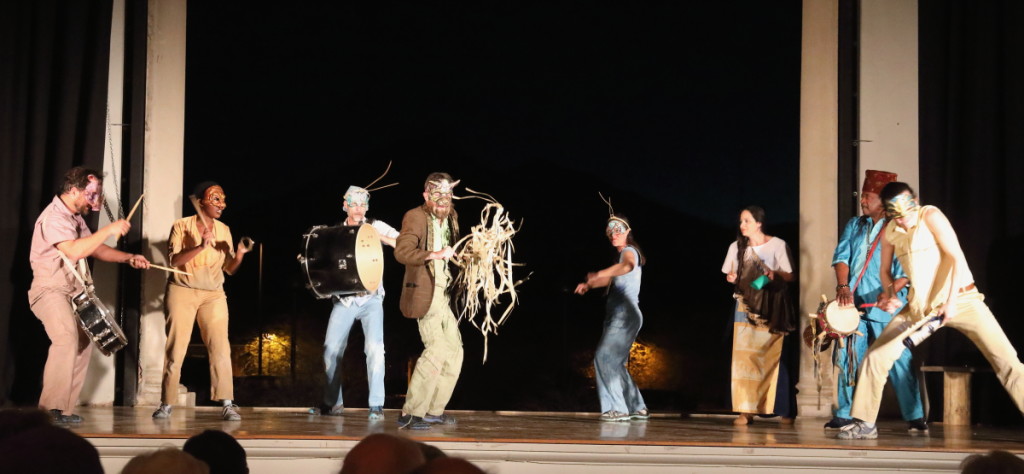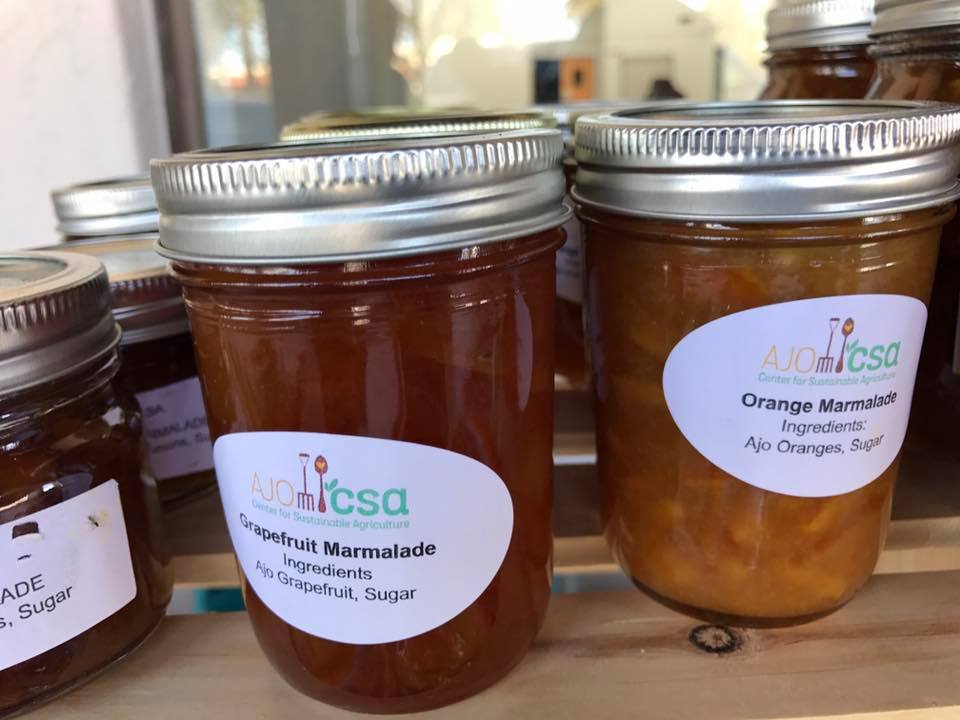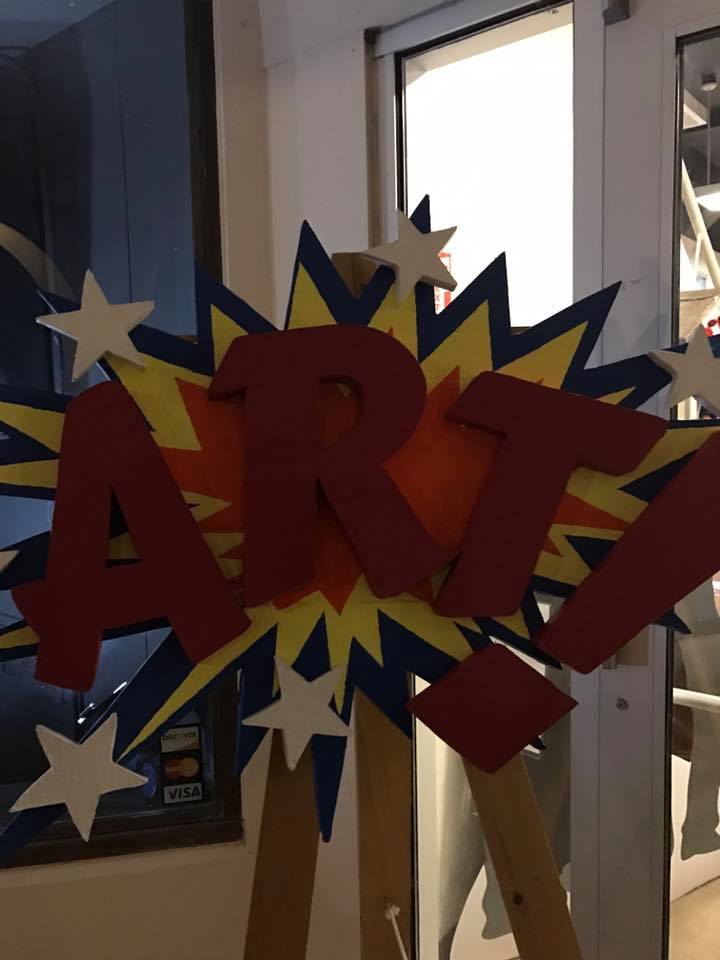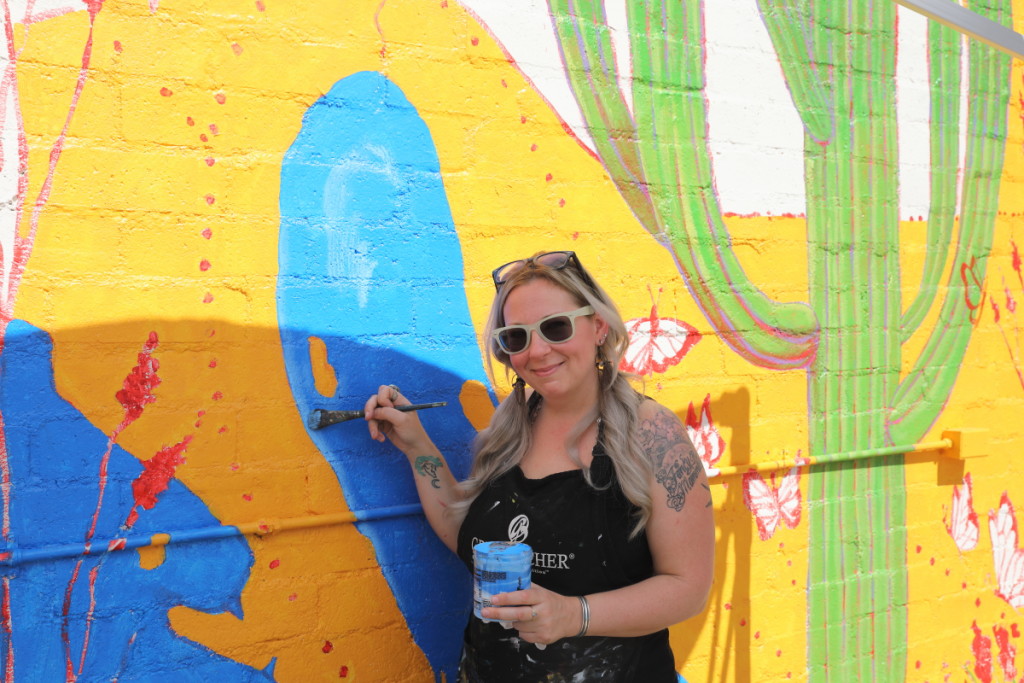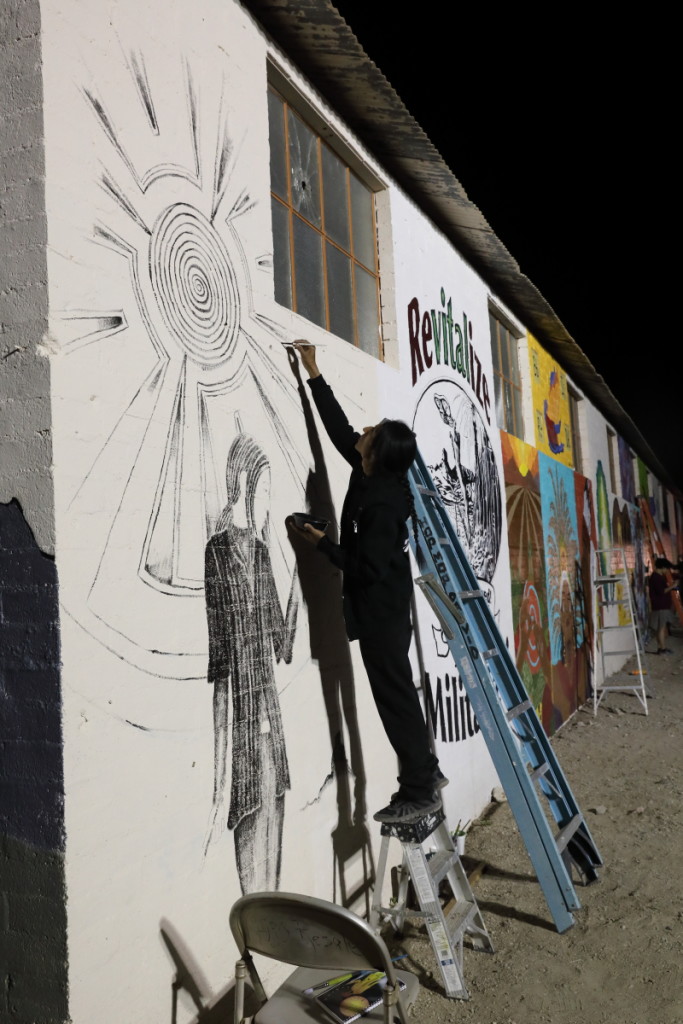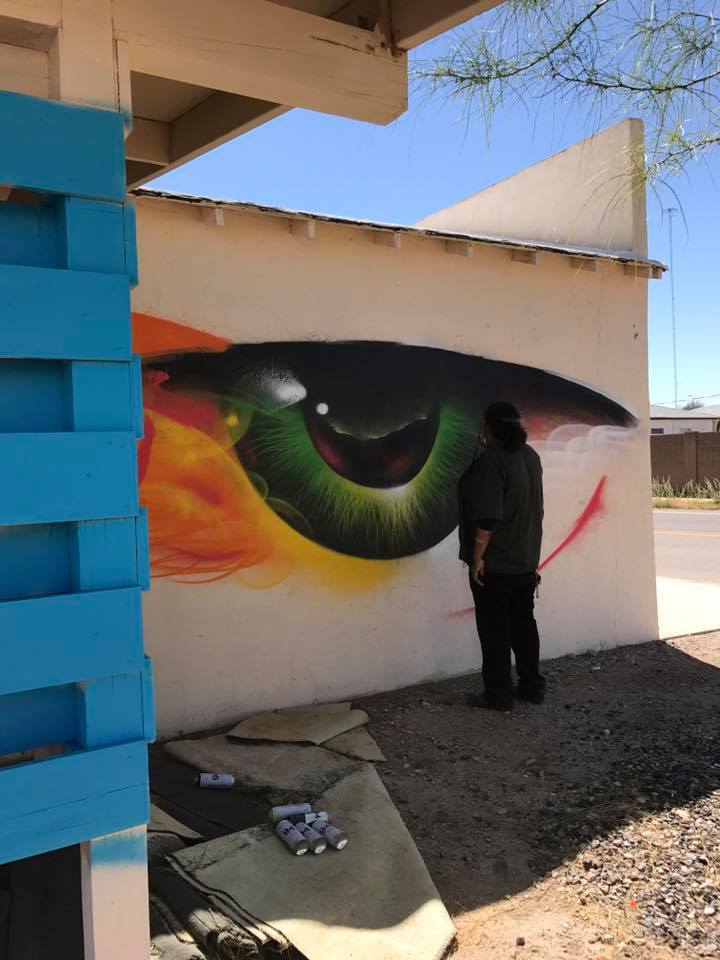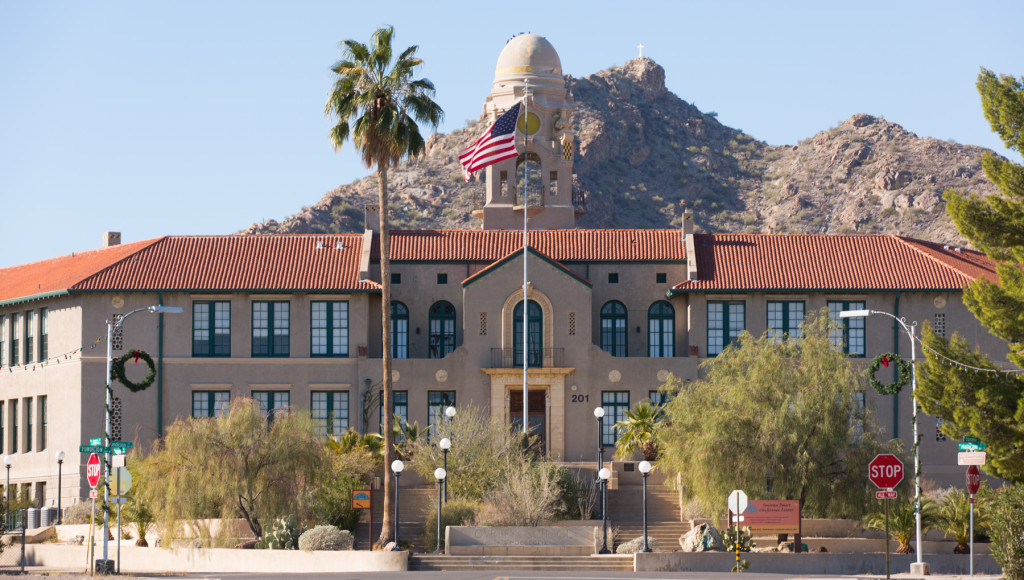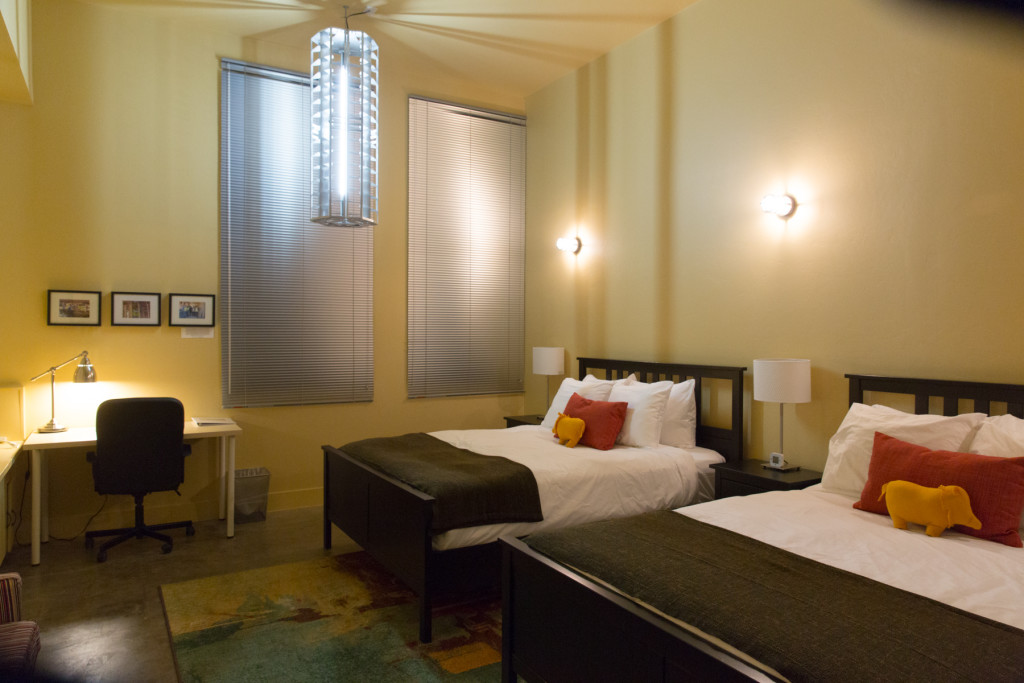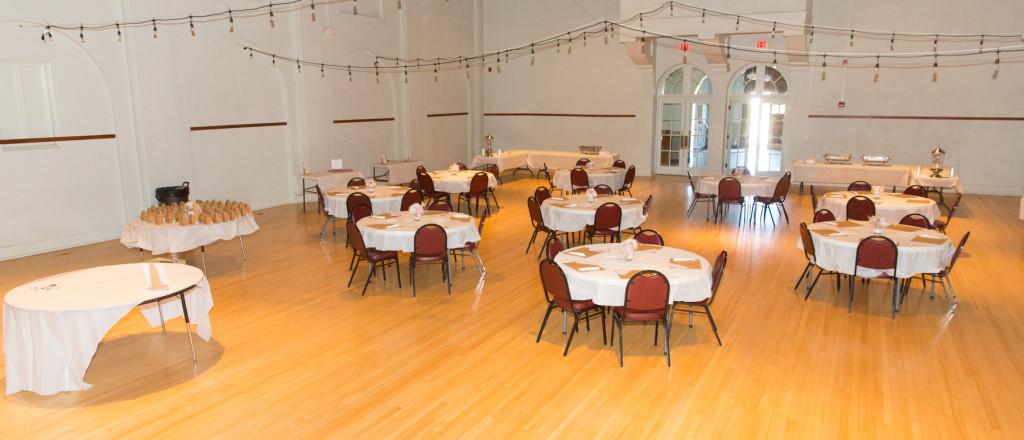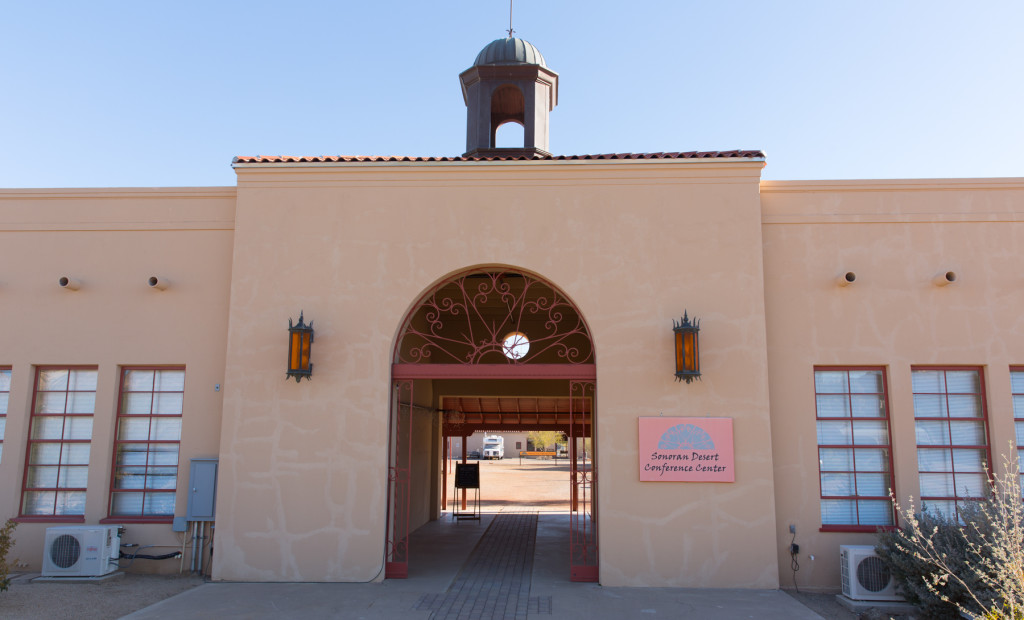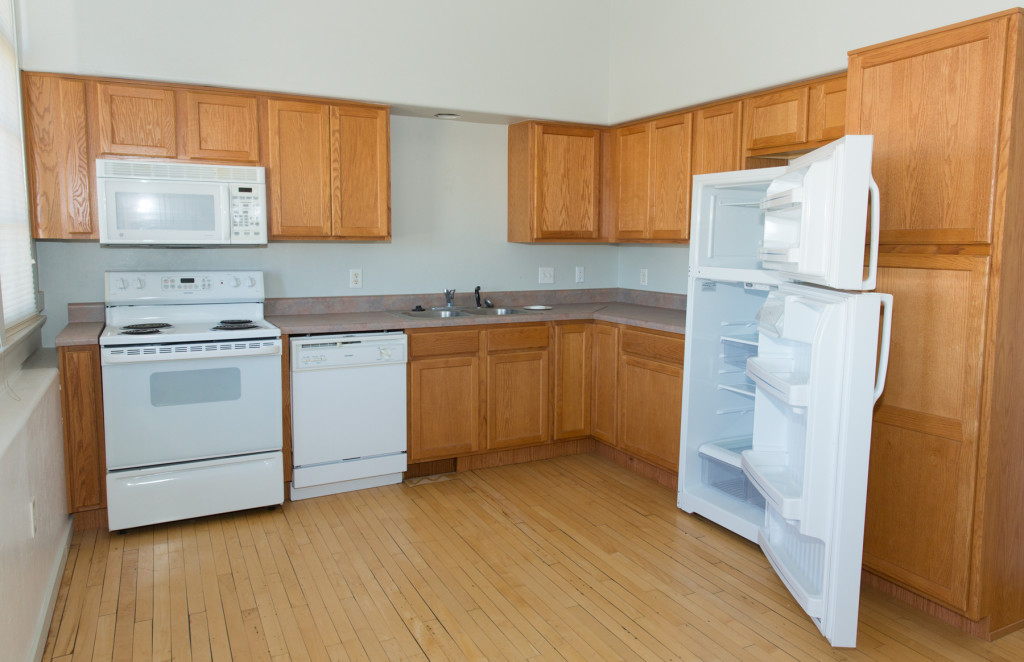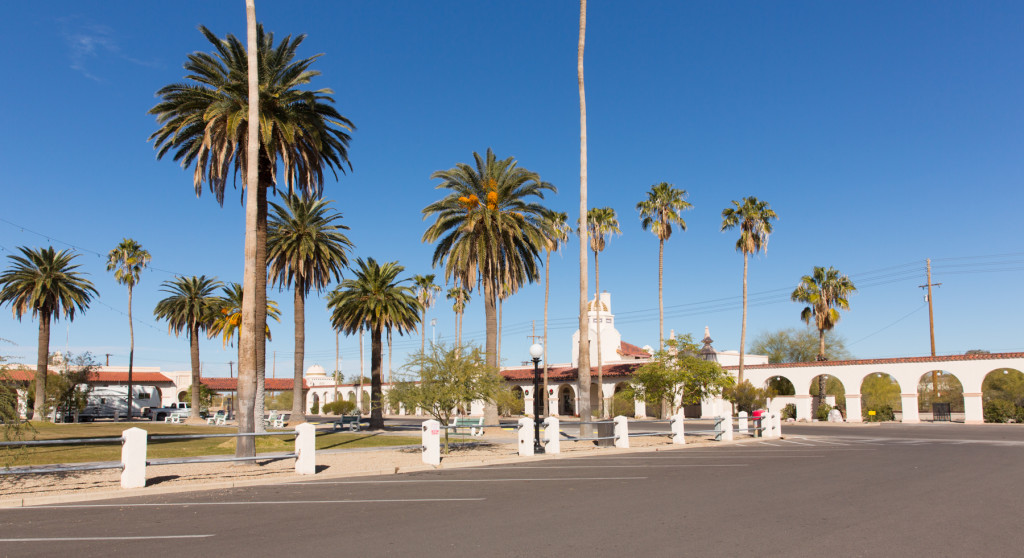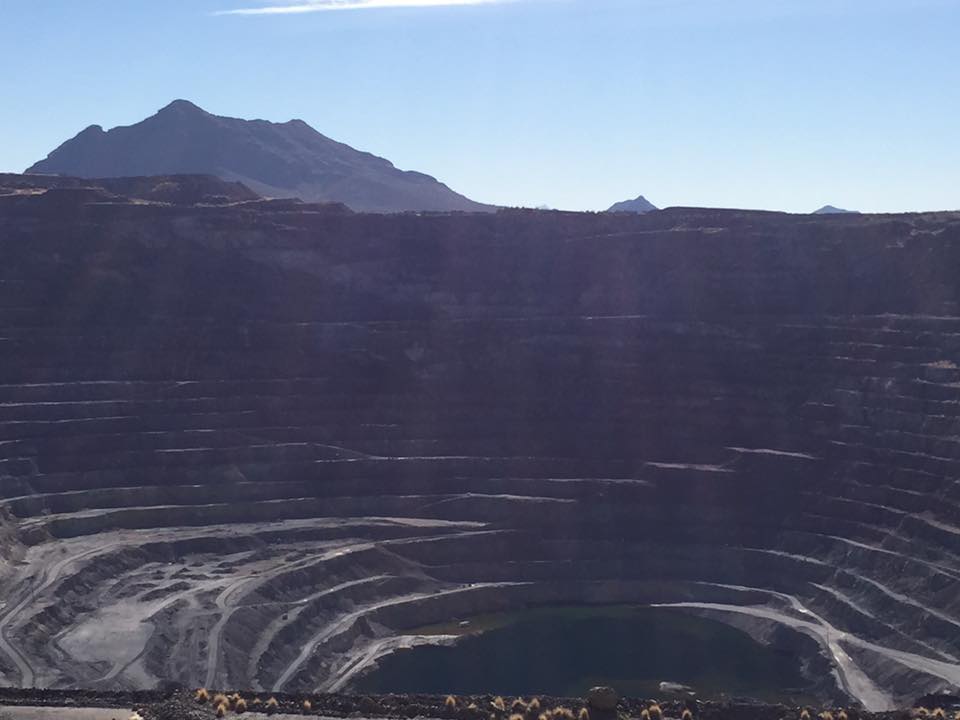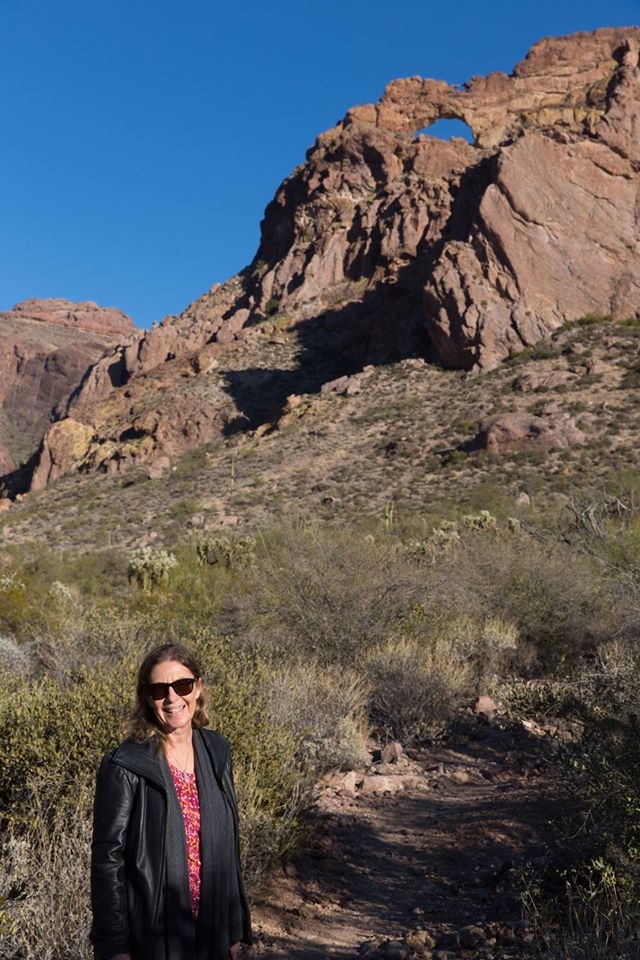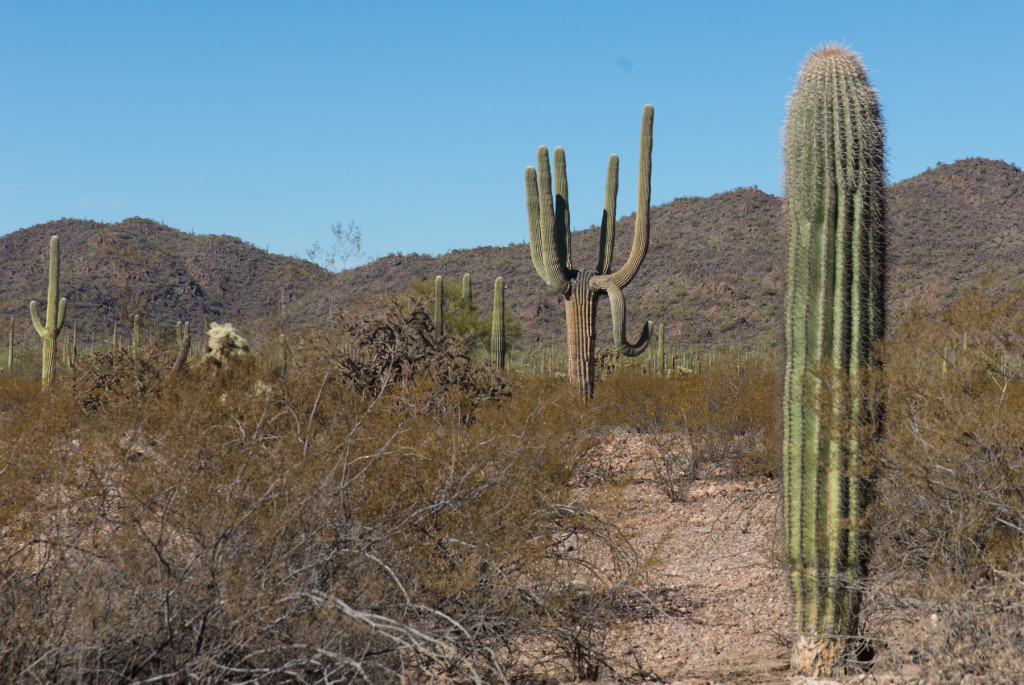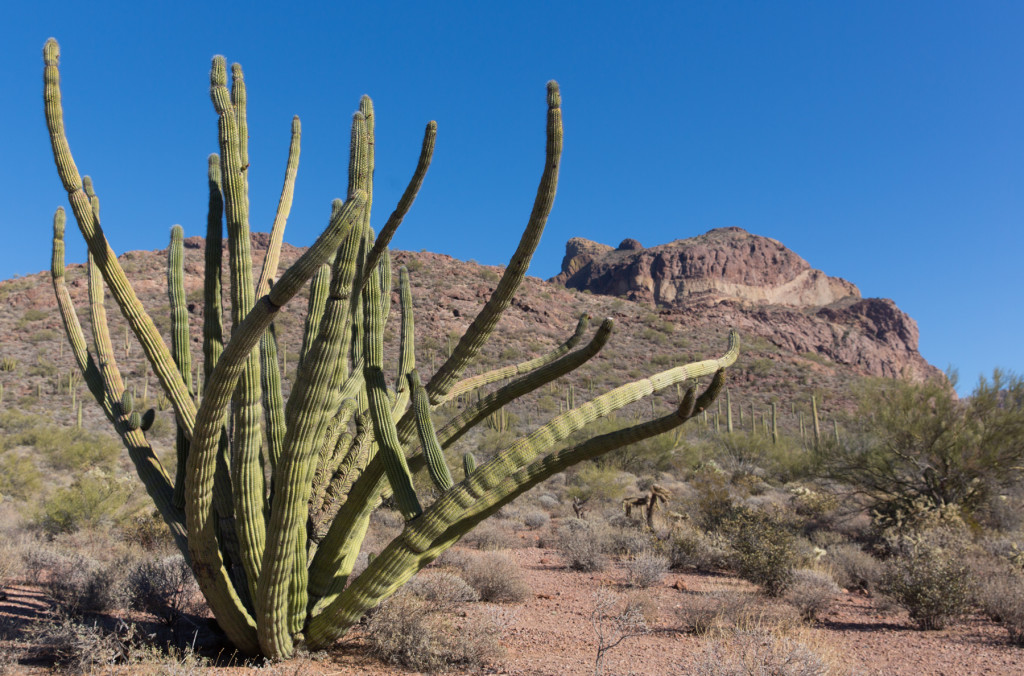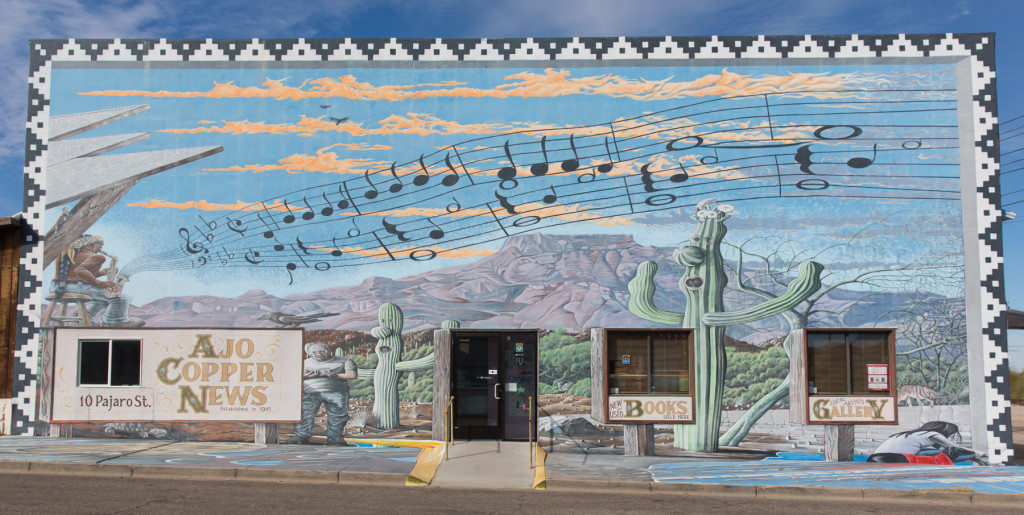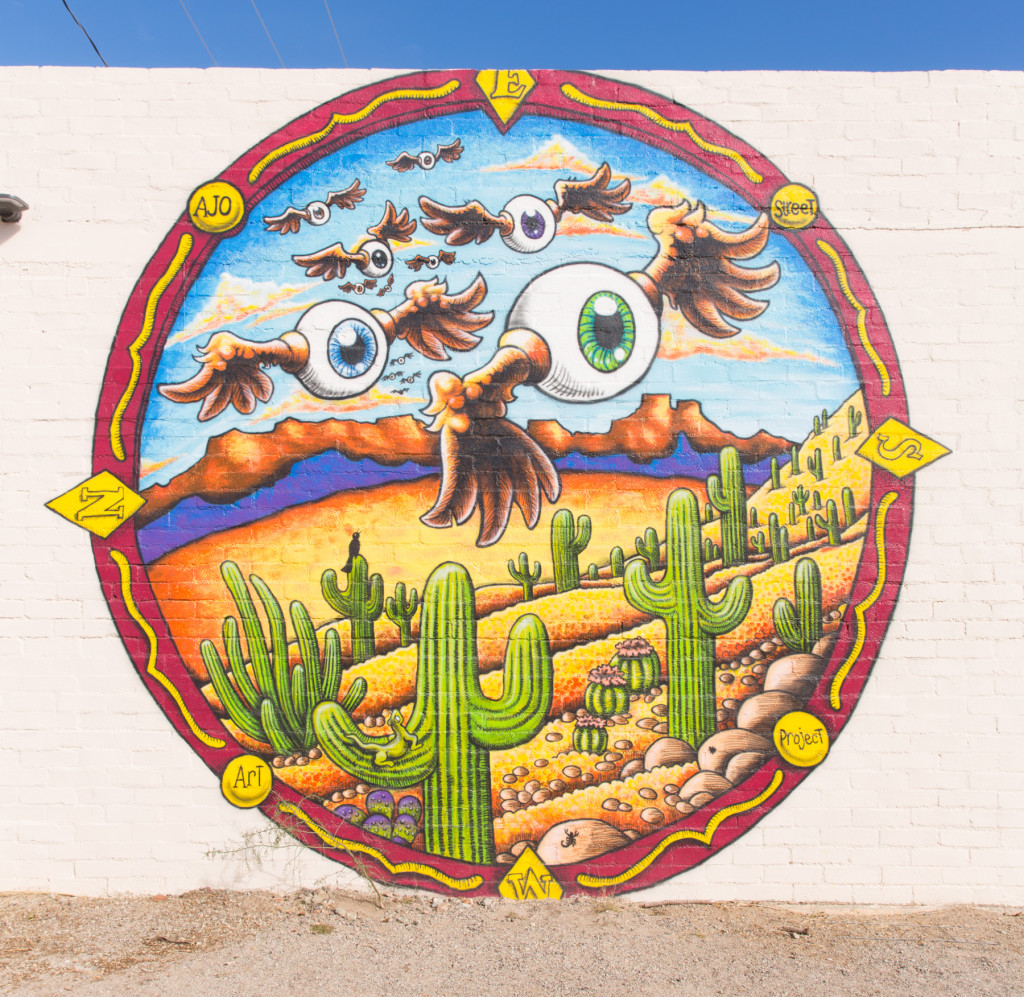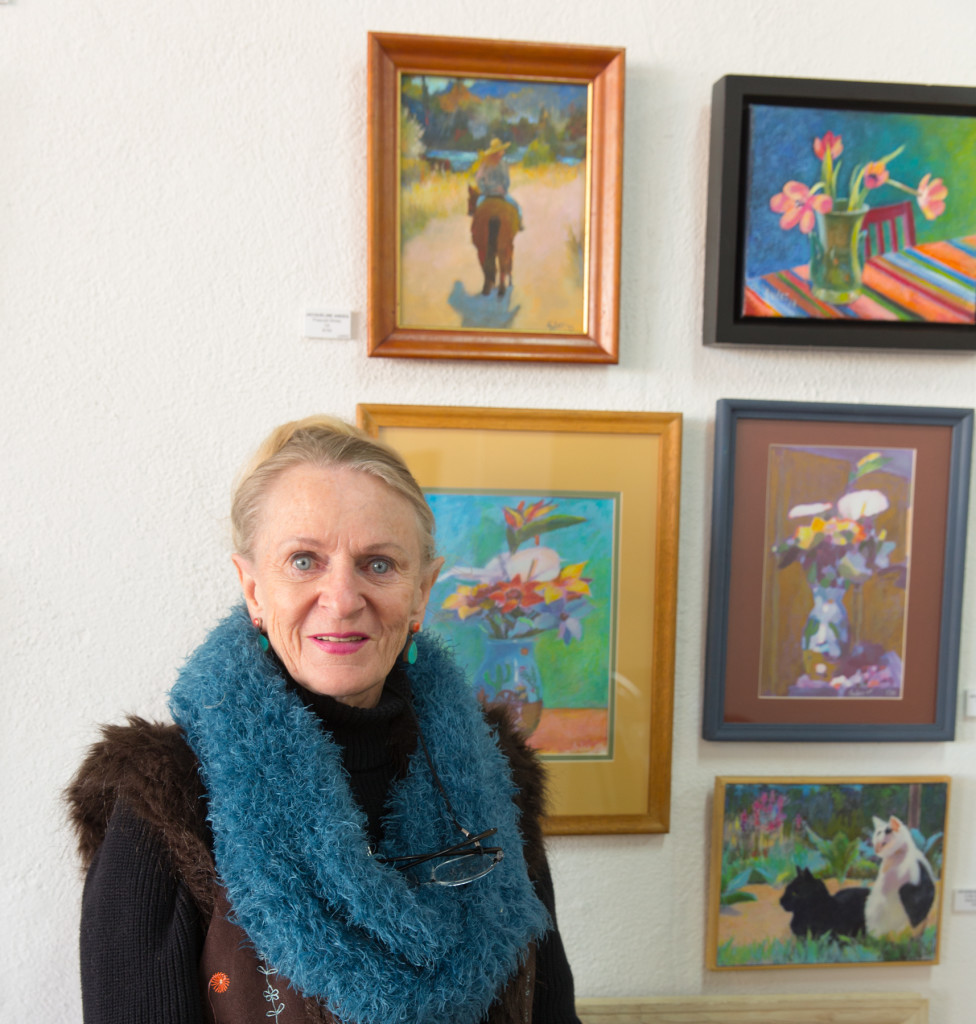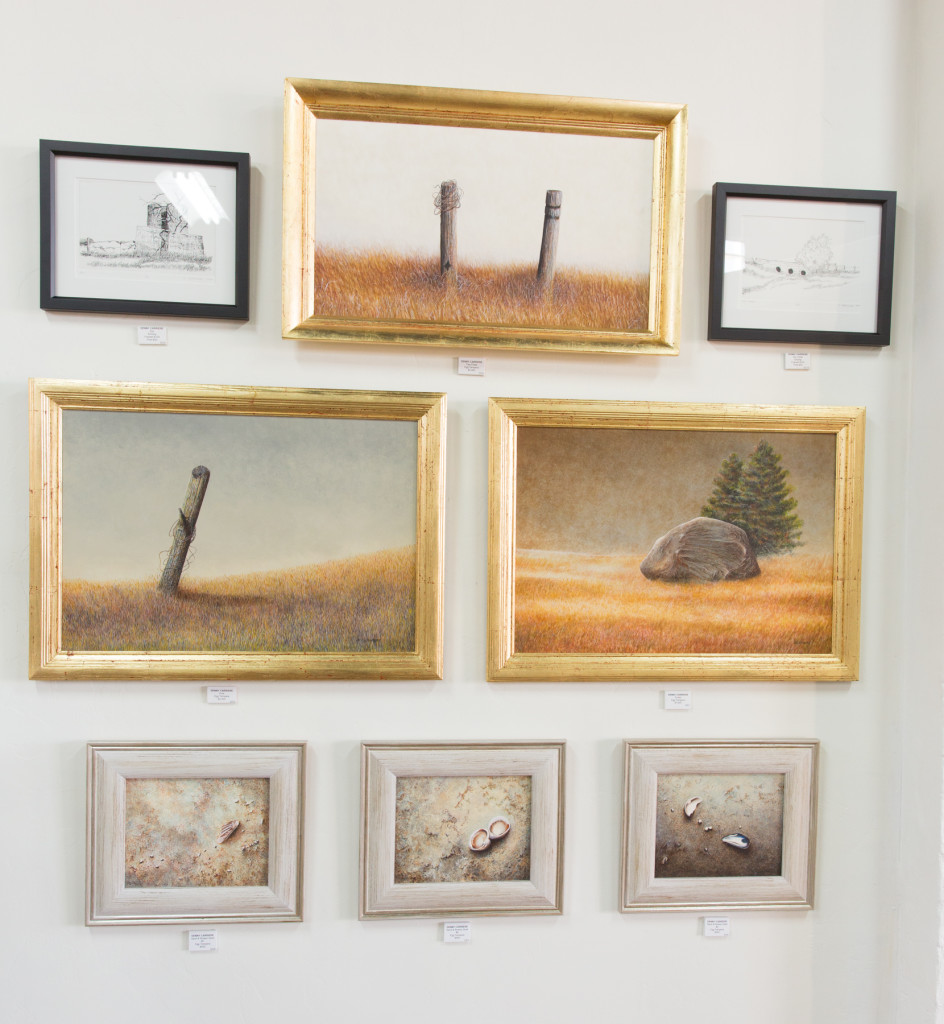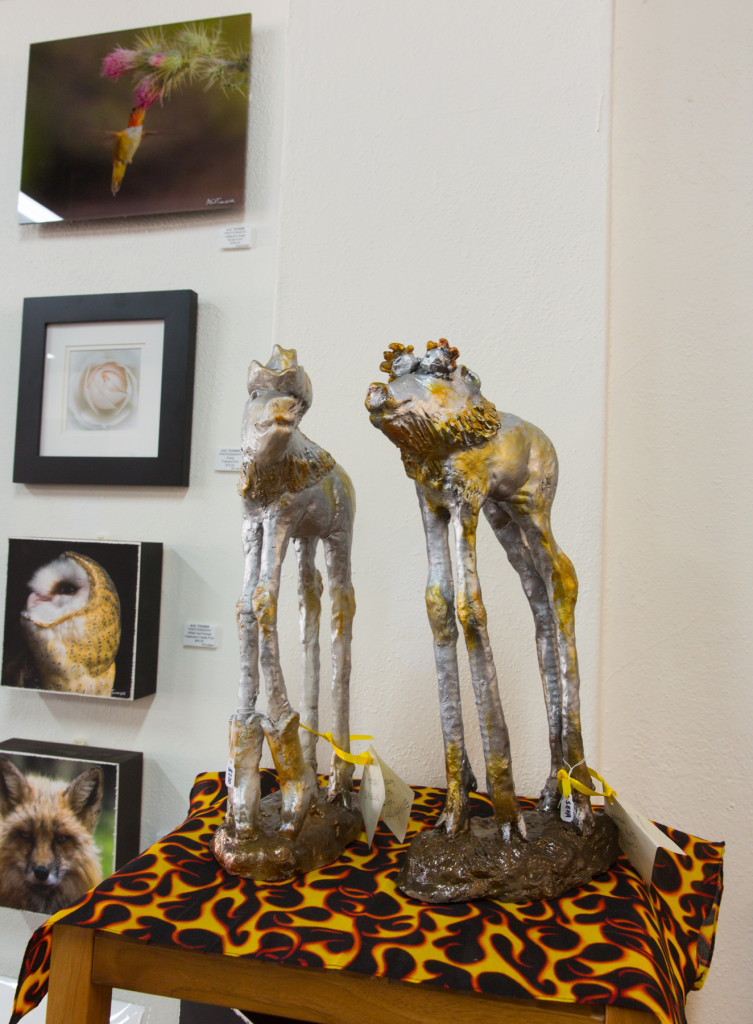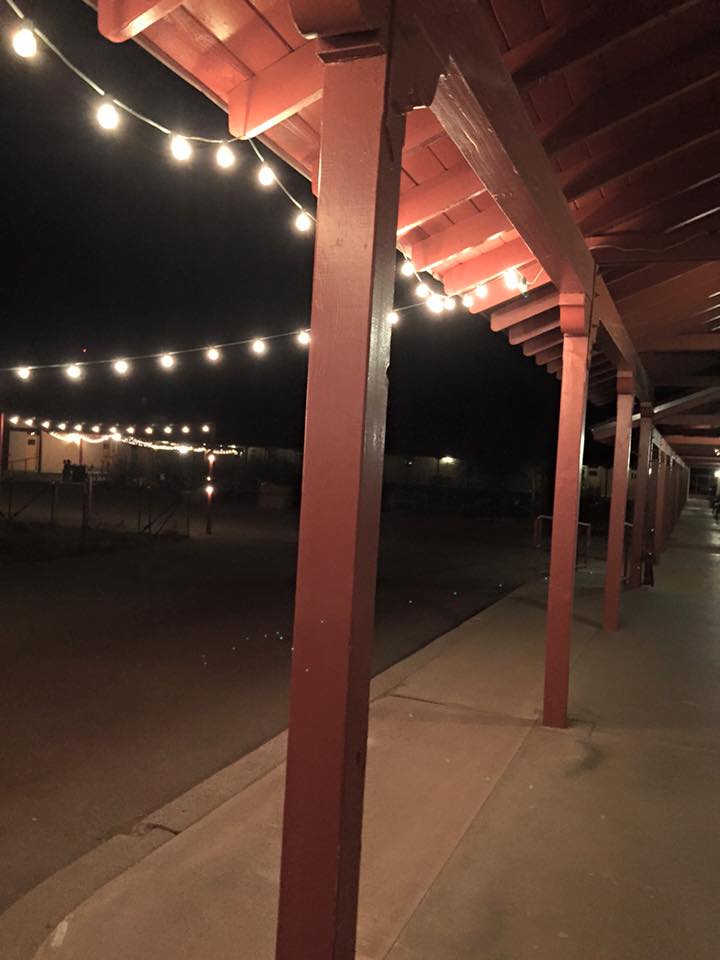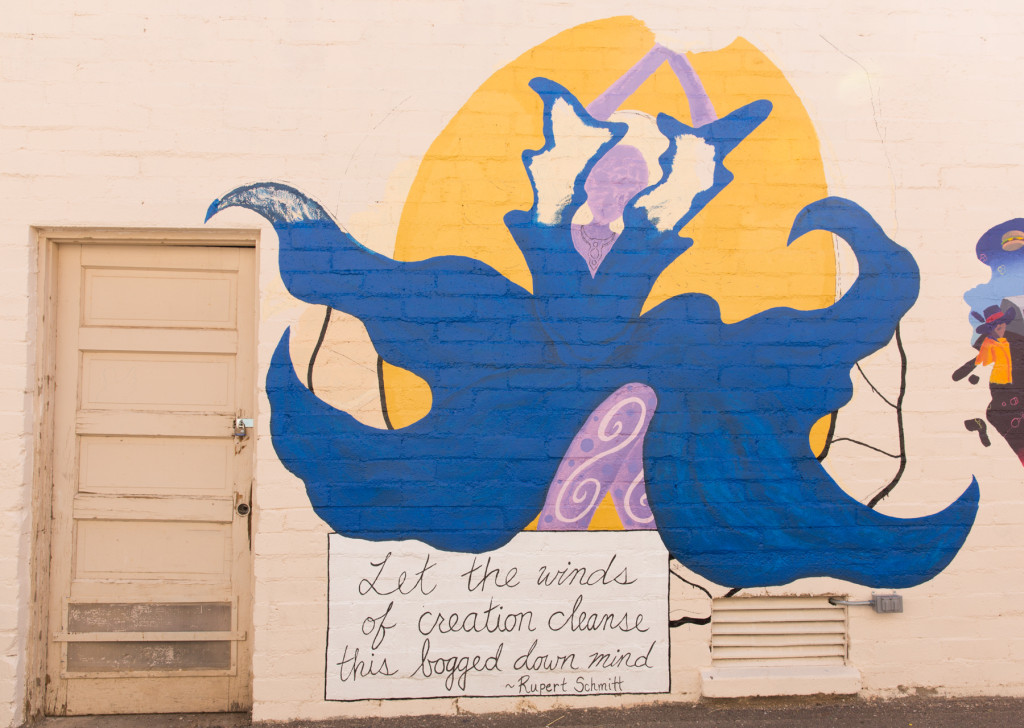Ajo, Ariz. is a unique community in transition. A former copper mining community, through the support of the International Sonoran Desert Alliance nonprofit, the town is remaking itself with a community non-profit gallery, beautiful living/working space lofts, and the Sonoran Desert Inn and Conference Center, a former elementary school that is now a unique and beautiful destination inn.
Above, a room at the Sonoran Desert Inn and Conference Center
Another part of the transition is a dedication to arts and culture, and the weekend of March 24-26th proved that undeniably with an arts program that included a stunning musical and dramatic performance by New Orleans-based Mondo Bizzaro and ArtSpot, three days of mural-painting in what is known as the town’s Artist’s Alley, and a buffet dinner of regional Tohono O’odham cuisine by Desert Rain Cafe.
Above: performance, mural art, and Native American cuisine.
The mural painting was a profound aspect of the weekend: the vastness of the project, the beauty of the work, and the way it spread from Artist’s Alley into the facades of buildings facing the street, was as natural and as vivid as the striking desert sunsets.
Above, Kat Anderson with her son – who contributed his artwork to one of her murals.
According to Kat Anderson who administered and coordinated – as well as participated in – the mural project, “It was amazing to watch this event take on its own energy and transform into something collectively that we would never have attained individually. We started with a budget of zero, a crazy dream, and a handful of artists with the dedication to organize and see it through. Now Ajo has 50 new murals and another impactful commUNITY experience to bond us closer, and empower our shared goals of revitalization.”
Muralists included:
Neoglyphix (a team of 8 led by Dwayne Manuel)
Porter McDonald
Micah Perry
Leanne Miller
L.T. Sparrow
Jah Rome
Caitlyn Allen
Nellie David
Amy Juan
Harriet Wood
Victor Garcia
Hop David
Kat Anderson
Silas Anderson
Delbert Antone
Maria Singleton
Harold Curtis
Ghazal Ghazi
Niki Ortiz
Jimmy Fennewald & Mitch Jacobs
Michael Schwartz
Valeria Hutchings
Izrael Rios Garcia
Mauriel Morejon
Catherine Ecker
Emma Bayne
Adan Alvarez
DaWolf Baker
Jake Boyd
Bike Ajo
Ajo CSA
Women Act Now
NCCC TeamKat
Anderson is an artist who lives in Ajo nine months of the year; the other three, in the height of the summer months, in Alaska. “I stumbled into murals. I’ve always been an artist, but never worked on anything bigger than canvas. Two years ago was the first street art happening in Ajo, and the first mural I ever painted. I got hooked on Ajo and on murals.”
Since that time, Anderson has created 12 murals in Ajo, Mexico, and Alaska, as well as continuing with her own studio paintings, poetry writing, and poetry readings. She describes her style as “a little surreal, a little abstract, vivid colors, some landscape and some my own imagination.” She adds that “I really tend towards thinking about things in colors and a collage of concepts. My painting and my writing both just pop into my head in pieces and then I put them together to create a greater motif.”
For Ajo’s mural festival, she created five murals, including a collaboration with artist Leanne Miller, as well as curating the event. “The first one, I took ten days to finish two years ago. I knew I couldn’t undertake that and run this, so instead I did smaller pieces. I had to have a paintbrush in my hand,” she laughs.
“This is the first year for me being in charge of the murals. The International Sonoran Desert Alliance didn’t have a grant for us, but I was able to see the vision of doing something out of nothing. The grass roots community really came together to show we could make something beautiful out of nothing,” she attests.
Anderson feels that with this year’s festival, the town has “broken through the threshold” in terms of the location of its murals, and that the town will be looking forward to welcoming murals throughout the community.
Artist Harriet Wood, based in Barcelona and previously from London, created one of the larger, most vivid pieces this year with her “Sonora.” The image covers an entire side of a two-story building.
“This piece is based on the wild life I stumbled across visiting Arizona. I never saw anything like it before. There’s a nod to native history in the headdress of my female figure, which I made as colorful as possible. I paint female characters for female empowerment,” she notes.
In terms of technique, Wood uses primarily spray paint with some brush work, but says she would’ve used all spray paint if she’d had enough available to complete the impressive work.
“I started spray painting eleven years ago at age fifteen. My dad was an artist, so I’m lucky, it was an accepted goal. My oldest friend lives in Tucson, and when I visited him in September I was introduced to Michael Schwartz and the Tucson Arts Brigade, who got me a wall,” she explains. “I’m staying here just a week, but I don’t want to leave this magical place,” she says.
Wood could not afford the cost necessary for paint, and crowd-sourced the project, which was extremely successful.
Wood’s participation in the arts weekend was long planned, but Mauriel Morejon merely drove by, saw the project, and wanted to join in. The professional muralist titled his swiftly and beautifully created project “Arizona Hurricane.”
Morejon creates dynamic, sweeping landscapes and stories.
Above, Izrael Rios Garcia created a stunning spray and air brushed acrylic work whose rich black background fills a large building corner and loading dock area.
Below, the muralists’ worked all day and into the night. The festive, creative scene was open to the public.
One of the strongest supporters of the mural project is Michael Schwartz, who brought Wood into the creation of murals in both Tucson and Ajo. He describes himself as being “all about community building.” A muralist and studio artist, he has gotten high school students involved in the artistic process, and is working on a multi-year collaboration between Tucson and Ajo involving young people.
Above, Schwartz with a young artist, Val Hutchings.
He’s created 125 murals over time. “Here I feel like it’s taking on a life of its own, the mural project. It’s great to start a wind-up toy and let it keep going. I talked to ISDA early on as to what culture is, we talked it through, and Kat ended up handling 90% of it all, we just did fundraisers online. Really, this is a hundred grand project, but we just came together. Normally, you wouldn’t do something like this without a grant, but we needed to be re-energized to do something for the community.” Schwartz believes that going “back to our roots” feels good particularly in our current political climate.
Along with the incredible, large-scale art work, the New Orleans-based Mondo Bizzaro and ArtSpot performance, funded by the National Performance Network, offered an immersive outdoor/indoor show that was as profound as it was beautiful.
Community artist and former ISDA community arts coordinator Morgana Wallace Cooper saw the performers in North Carolina and knew they would be a passionate fit for the festival.
Performing troupe member Monique Verdin noted that while their primarily outdoor performance is not usually done at night, creating their work at dusk “added a new quality. Everyone really let loose with the Fais de Doux.”
The eco-performance combined historically-based drama with hauntingly magical music. The subject matter dealt with the Army Corps of Engineers reconfiguring the Mississippi, industrial pollution, and environmental racism, a subject that might have been set in Louisiana culture, but which still resonated for Ajo with its mining past.
The group led its audience from Ajo’s town square indoors to the beautiful auditorium at the renovated Curley School adjacent to the Sonoran Desert Inn and Conference Center. Haunting melodies were paired with floor to ceiling photographs of the Louisiana region, while the backdrop to the auditorium’s stage was the rolled-open loading dock, creating an amazing intermingling of Arizona sunset sky and Cajun melodies.
It would be hard to put into words both how powerful and how dream-like the performance was, and how well it fit the almost dream-like quality of Ajo itself: here is a town that is in the process of reinvention, painting itself into revitalized life with enormous murals, serving up a spring arts festival as beautifully realized as any in a much larger community.
Don’t wait to visit Ajo and view the murals and absorb the town’s special magic, from it’s sprightly farmer’s market to it’s art gallery openings; and do look forward to the town’s next Spring Arts Festival.
Above and below: farmer’s market; opening at Under the Arches Gallery.
Above, artists’ renderings of mural works; below a delightful crafts project.
Below, another look at some of the beautiful murals created during the Spring Arts Weekend.
- Genie Davis; Photos: Jack Burke


